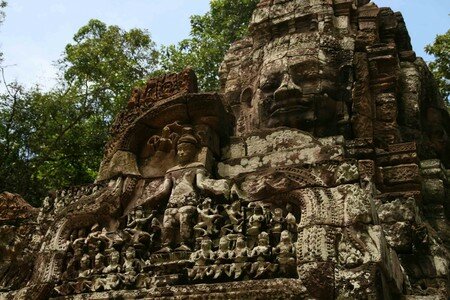Ta Som
.
From the eastern Mebon, Ta Som appears on the right, a little after the 13th kilometre marker stone, as a tower with four faces of Lokesvara entwined within the roots of a giant Ficus tree that crowns it perfectly. Several of the roots have pierced the vault and descend straight to the ground, obstructing part of the passageway.
Cruciform in plan, this gopura is flanked by two small rooms and adjoins the 200 by 240 metre laterite wall of the external (the third) enclosure. Its western lintel shows the standing bodhisattva surrounded by worshippers. There is a similar gopura to the east with the same fronton, preceded externally by a small terrace bordered with naga-balustrades - the temple having a double entrance.
.
Ta Som lies on the extension of the Prah Khan-Neak Pean axis, and must represent, in its diminutive size, a single unified development typical of the monuments appearing in the last period of the style of the Bayon. It appears to be exactly like the external enclosures of Ta Prohm and of Banteay Kdei. In all its parts the same elements recur - false windows with lowered blinds, small devatas - which are rough and rustic - and an embroidery of organic decoration on a background of foliated scrolls in profusion on the walls.
In an advanced state of ruin, the various buildings which still stand have been the object of some provisional consolidation and basic clearing work. The internal courtyard remains littered with fallen blocks and the ensemble is, in its verdant setting, quite charming. After the first gopura, a pavement bordered by nagas with large garudas crosses the moat. The laterite wall of the second enclosure is divided to the east and west by cruciform sandstone gopuras, each with small wings to either side and open only to the outside with balustered windows. Preceded by porticoes, they are covered by a crossing of barrel-formed vaults.
The first enclosure is formed by a gallery of 20 metres by 30. These are built in laterite and sandstone, as are the corner pavilions with their crossing vaults and moulded false doors. The four gopuras, entirely in sandstone, are in the form of a tower with two reducing upper tiers topped with a crowning motif. The plan remains the same as the other enclosures, as does the mural decoration.
.
Walking around the exterior one passes successively the north-west and north-east corners – the latter of which has completely collapsed - to gain access to the internal courtyard by the small door in the gallery, situated on the south side between the south-east corner and the gopura.
Climbing over the fallen blocks, one will see the two “library” type buildings on the right, opening to the east - the northern of which is badly ruined - and then the imposing mass of the central sanctuary, cruciform in plan with four vestibules. The sanctuary chamber, which is open on its four sides, has an ornate cornice and is decorated “in tapestry” at the base of the walls.
The tympanums of the gopuras, sculpted with banded scenes, are not without some interest - particularly that on the south side of the north gopura, where four figures in prayer frame a fifth who stands. Defaced at the time of the 13th century Brahmanic reaction he was carried, as are the others, on a lotus and surmounted by flying figures. In the south-west and north-west corners of the courtyard stand two sandstone pillars with a top tenon that are similar to those at Prah Khan, Ta Prohm and Banteay Kdei.






/http%3A%2F%2Fstorage.canalblog.com%2F65%2F83%2F88988%2F19477867_o.jpg)
/http%3A%2F%2Fstorage.canalblog.com%2F47%2F35%2F88988%2F19477489_o.jpg)
/http%3A%2F%2Fstorage.canalblog.com%2F44%2F87%2F88988%2F19247205_o.jpg)
/http%3A%2F%2Fstorage.canalblog.com%2F35%2F56%2F88988%2F19247076_o.jpg)
/https%3A%2F%2Fstorage.canalblog.com%2F68%2F13%2F88988%2F131346695_o.jpg)
/https%3A%2F%2Fstorage.canalblog.com%2F46%2F43%2F88988%2F47990981_o.jpg)
/https%3A%2F%2Fstorage.canalblog.com%2F34%2F23%2F88988%2F47957389_o.jpg)
/https%3A%2F%2Fstorage.canalblog.com%2F69%2F48%2F88988%2F47956242_o.jpg)
/https%3A%2F%2Fstorage.canalblog.com%2F71%2F12%2F88988%2F21063019_o.jpg)